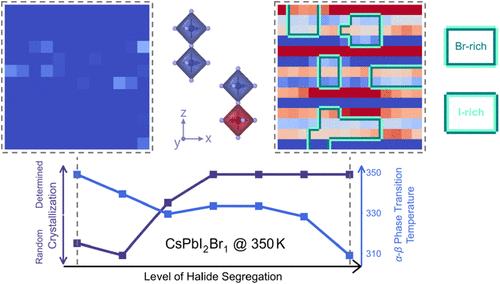Phase Stability and Transformations in Lead Mixed Halide Perovskites from Machine Learning Force Fields
IF 7
2区 材料科学
Q2 CHEMISTRY, PHYSICAL
引用次数: 0
Abstract
Lead halide perovskites (APbX3) offer tunable optoelectronic properties, but feature an intricate phase stability landscape. Here, we employ on-the-fly data collection and an equivariant message-passing neural network potential to perform large-scale molecular dynamics of three prototypical lead mixed-halide perovskite systems: CsPbX3, MAPbX3, and FAPbX3. Integrating these simulations with the PDynA structure analysis toolkit, we resolve both equilibrium phase diagrams and the dynamic structural evolution under varying temperatures and halide mixtures. Our findings reveal that A-site cations strongly modulate tilt modes and phase pathways: MA+ effectively “forbids” the β-to-γ transition in MAPbX3 by requiring extensive molecular rearrangements and crystal rotation, whereas the debated low-temperature phase in FAPbX3 is predicted to be best represented as an Im3̅ (a+a+a+) cubic phase. Additionally, small changes in halide composition and arrangement, from uniform mixing to partial segregation, alter octahedral tilt correlations. Segregated domains can even foster anomalous tilting modes that impede uniform phase transformations. These results highlight the multiscale interplay between the cation environment and halide distribution, offering a route for tuning perovskite architectures toward improved phase stability and control.

基于机器学习力场的铅混合卤化物钙钛矿的相稳定性和相变
卤化铅钙钛矿(APbX3)具有可调谐的光电特性,但具有复杂的相稳定性景观。在这里,我们利用实时数据收集和等变信息传递神经网络电位对CsPbX3、MAPbX3和FAPbX3三种典型铅混合卤化物钙钛矿体系进行了大规模分子动力学研究。将这些模拟与PDynA结构分析工具包相结合,我们解决了平衡相图和在不同温度和卤化物混合物下的动态结构演变。我们的研究结果表明,a位阳离子强烈调节倾斜模式和相途径:MA+通过需要广泛的分子重排和晶体旋转,有效地“禁止”MAPbX3中β到-γ的转变,而FAPbX3中有争议的低温相被预测为Im3 (a+a+a+)立方相。此外,卤化物成分和排列的微小变化,从均匀混合到部分偏析,改变了八面体倾斜相关性。分离的畴甚至会形成阻碍均匀相变的异常倾斜模式。这些结果突出了阳离子环境和卤化物分布之间的多尺度相互作用,为调整钙钛矿结构以改善相稳定性和控制提供了一条途径。
本文章由计算机程序翻译,如有差异,请以英文原文为准。
求助全文
约1分钟内获得全文
求助全文
来源期刊

Chemistry of Materials
工程技术-材料科学:综合
CiteScore
14.10
自引率
5.80%
发文量
929
审稿时长
1.5 months
期刊介绍:
The journal Chemistry of Materials focuses on publishing original research at the intersection of materials science and chemistry. The studies published in the journal involve chemistry as a prominent component and explore topics such as the design, synthesis, characterization, processing, understanding, and application of functional or potentially functional materials. The journal covers various areas of interest, including inorganic and organic solid-state chemistry, nanomaterials, biomaterials, thin films and polymers, and composite/hybrid materials. The journal particularly seeks papers that highlight the creation or development of innovative materials with novel optical, electrical, magnetic, catalytic, or mechanical properties. It is essential that manuscripts on these topics have a primary focus on the chemistry of materials and represent a significant advancement compared to prior research. Before external reviews are sought, submitted manuscripts undergo a review process by a minimum of two editors to ensure their appropriateness for the journal and the presence of sufficient evidence of a significant advance that will be of broad interest to the materials chemistry community.
 求助内容:
求助内容: 应助结果提醒方式:
应助结果提醒方式:


